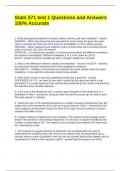Exam (elaborations)
Stats 571 test 1 Questions and Answers 100% Accurate
- Course
- Institution
Stats 571 test 1 Questions and Answers 100% Accurate 1. What distinguishes between nominal, ordinal, interval, and ratio variables? NOMINAL - When two things that are equivalent in some sense are given the same name or number but there are more than two possibilities. (1-10 in sports jerseys) OR...
[Show more]



